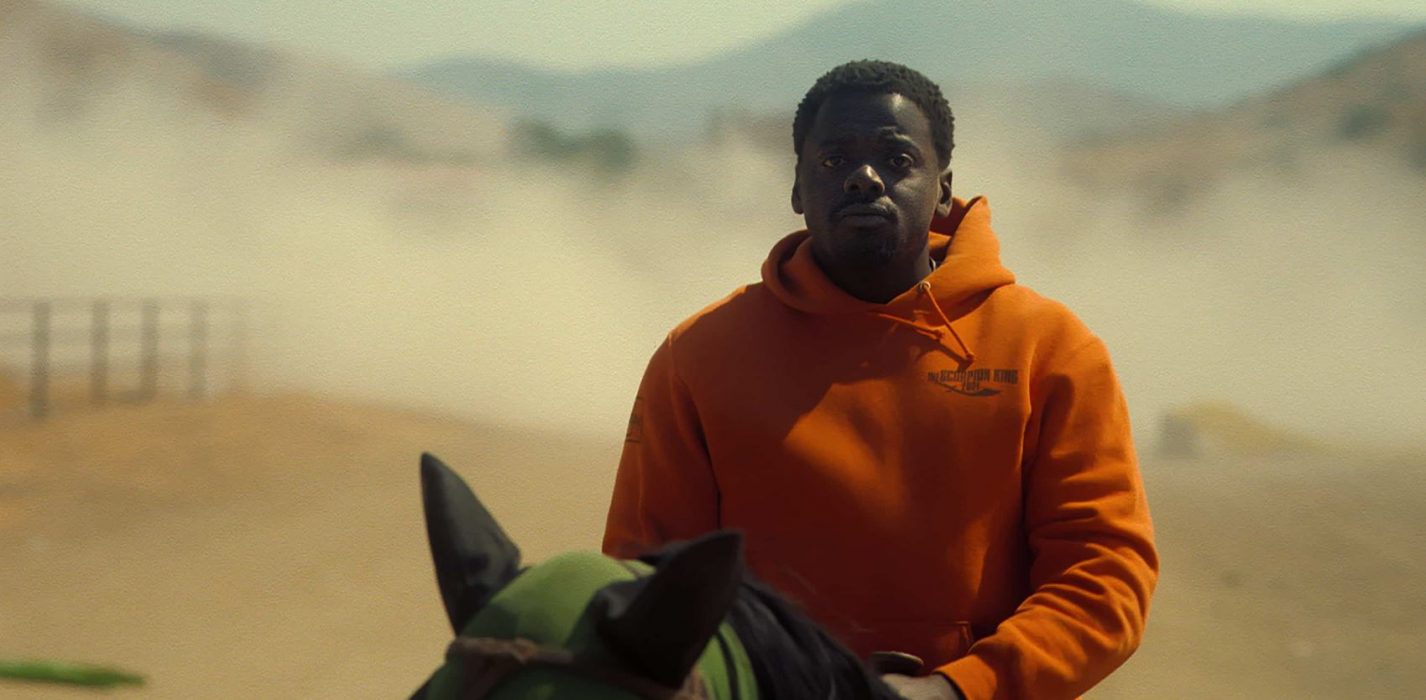| Worth seeing: | as a sci-fi horror that brings Jordan Peele somewhat down to earth with a bump, rather than delivering an truly out-of-this-world experience |

| Director: | Jordan Peele |
| Featuring: | Daniel Kaluuya, Keke Palmer, Steven Yeun, Brandon Perea, Keith David, Michael Wincott, Terry Notary |
| Length: | 130 minutes |
| Certificate: | 15 |
| Country: | US |
| Released: | 12th August 2022 |
WHAT’S IT ABOUT?
OJ (Daniel Kaluuya) and Emerald (Keke Palmer) Haywood run a horse ranch outside Los Angeles, training animals to work on film sets in nearby Hollywood.
Their father has recently died, being killed by a freak storm of small metal objects that rained down from the sky.
OJ and Emerald have been looking up a lot since then – and they spot and unidentified flying object that seems to be haunting them – popping out from behind a cloud that never seems to move – hovering overhead and then disappearing behind the cloud again.
They get a local tech expert (Brendan Perea) to set them up with a security camera system to try to film the UFO and hire a respected cinematographer (Michael Wincott) to try to catch it on film.
Not too far away, a former child star, Ricky (Steven Yeun) runs a cowboy-themed tourist attraction, which is using the UFO to draw in additional visitors.
But the flying saucer is not content with providing entertainment or terrorising the defenceless humans down below – it’s here for a reason…
WHAT’S IT LIKE?
With Jordan Peele reuniting with Daniel Kaluuya, the star of his breakout social horror hit Get Out, and following on from his interesting – but flawed – doppelganger chiller Us, Nope has long been hotly anticipated by genre fans. Much as M Night Shyalaman’s follow-up to The Sixth Sense and Unbreakable, Signs.
But while it models itself on Spielberg’s Close Encounters of the Third Kind, it feels more like a Signs – the film which made the bold and influential film-maker of his earlier films look more like an over-reaching prima donna.
This film is all about the set-up, but the pay-off never lives up to its potential.
The pair at its heart are an interesting set of siblings; he’s quiet, economical with his words – if he can’t believe what he sees, a UFO, for example, he’ll simply say an incredulous, “Nope;” she’s a fast-talking, wise-cracking motor-mouth, with the confidence of the Hollywood stars her horses perform alongside.
The contrast between the two – in the face of adversity – is fascinating – as Kaluuya does almost all of his acting by opening his eyes as wide as he can, while Palmer talks the hind-legs of her horses at every opportunity. Kaluuya’s eyes should perhaps be nominated for supporting actor awards in the New Year.
The rag-tag gang they build to confront the celestial visitor works well too – the enthusiastic young, Hispanic electronics whizz and the gravelly-voiced, wizened old cameraman.
The way they play hide-and-seek – or perhaps chess is a better simile – with the UFO is initially fascinating to watch but the denouement fails to meet its earlier potential and leaves too many questions.
And when we learn more about what the UFO turns out to be, it’s an noteworthy twist – that doesn’t really go anywhere as interesting as its inspirations might signpost.
Then there’s Terry Notary. You know if you see his name in the credits, you’re going to see an ape doing something no director could persuade it to do – like, say, brutally punch a middle-aged white couple to death on a TV set, while a young Korean boy watches from under the table. This young Korean boy, by the way, grows up to be Ricky, although what relevance this whole back-story has to the UFO storyline, who knows?
Given the provenance of this film, many viewers might be looking for an analogy for racial commentary, and while the main characters are black and the main supporting cast are Hispanic and Korean, you might wonder who’s representing white people; the UFO? the ape? the couple killed by the ape? Then who does the ape represent? Or maybe there’s no racial subtext to this at all?
There is a more on-the-nose reference to race, where it emerges that the siblings are descendants of the black jockey seen in one of the earliest pieces of film – no-one can remember his name – suggesting that black film pioneers have been forgotten by Hollywood – driving OJ and Emerald’s push for recognition.
Devoid of an obvious interpretation and full of red herrings, this feels too much like an unsatisfying example of the Emperor’s new clothes, but there are enough flashes of Peele’s undoubted creativity amid a backdrop of effective genre tropes to make it at least worth a look.
But be aware that it’s more of a creature-feature than a thought-provoking study of existentialism and while it plays more as a horror, there’s a chilling sense of foreboding that fails to convert into real scares.
So if you’re wondering whether Jordan Peele’s follow-up to Get Out and Us is out-of-this-world, I’m afraid the answer is a clear “Nope!”
